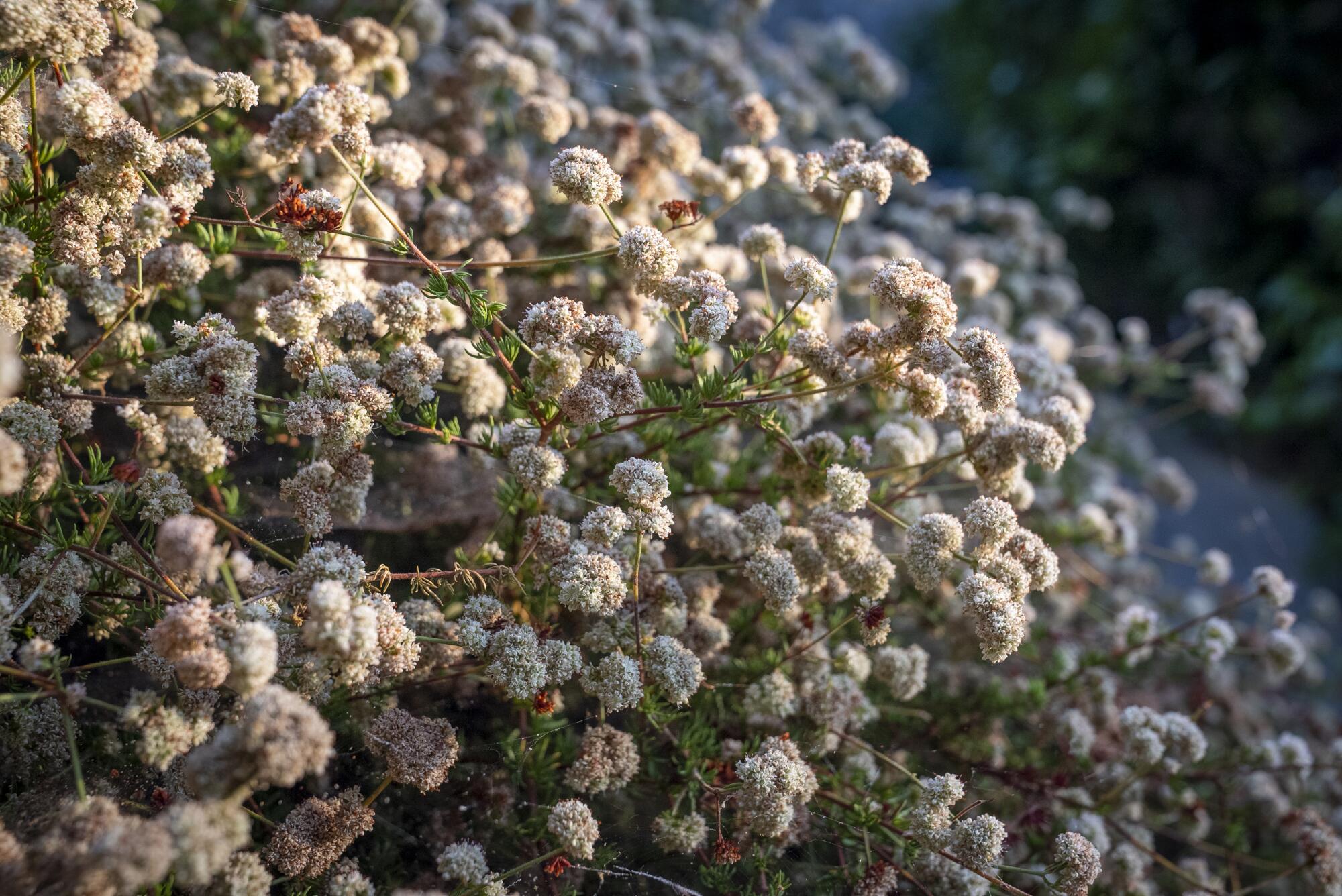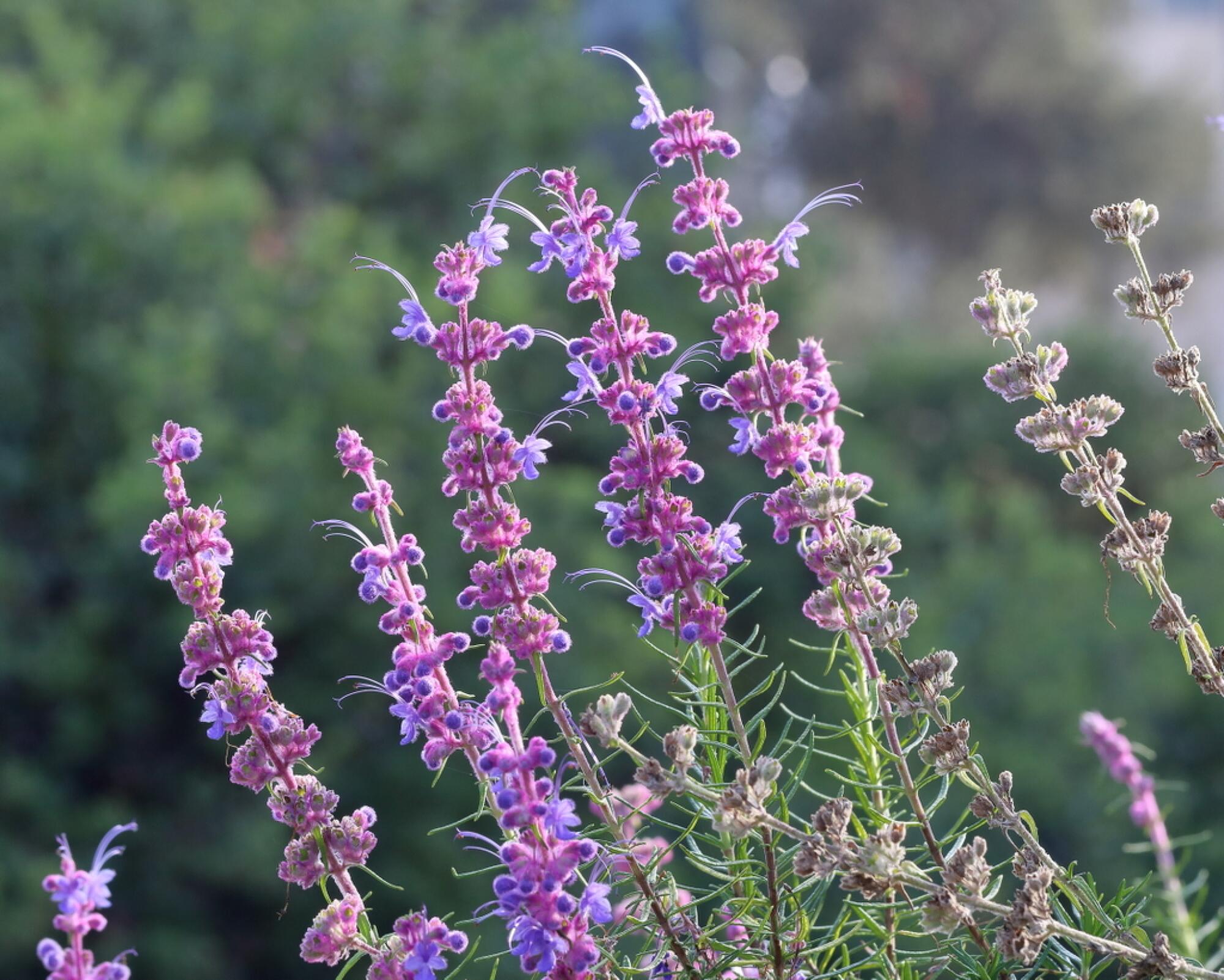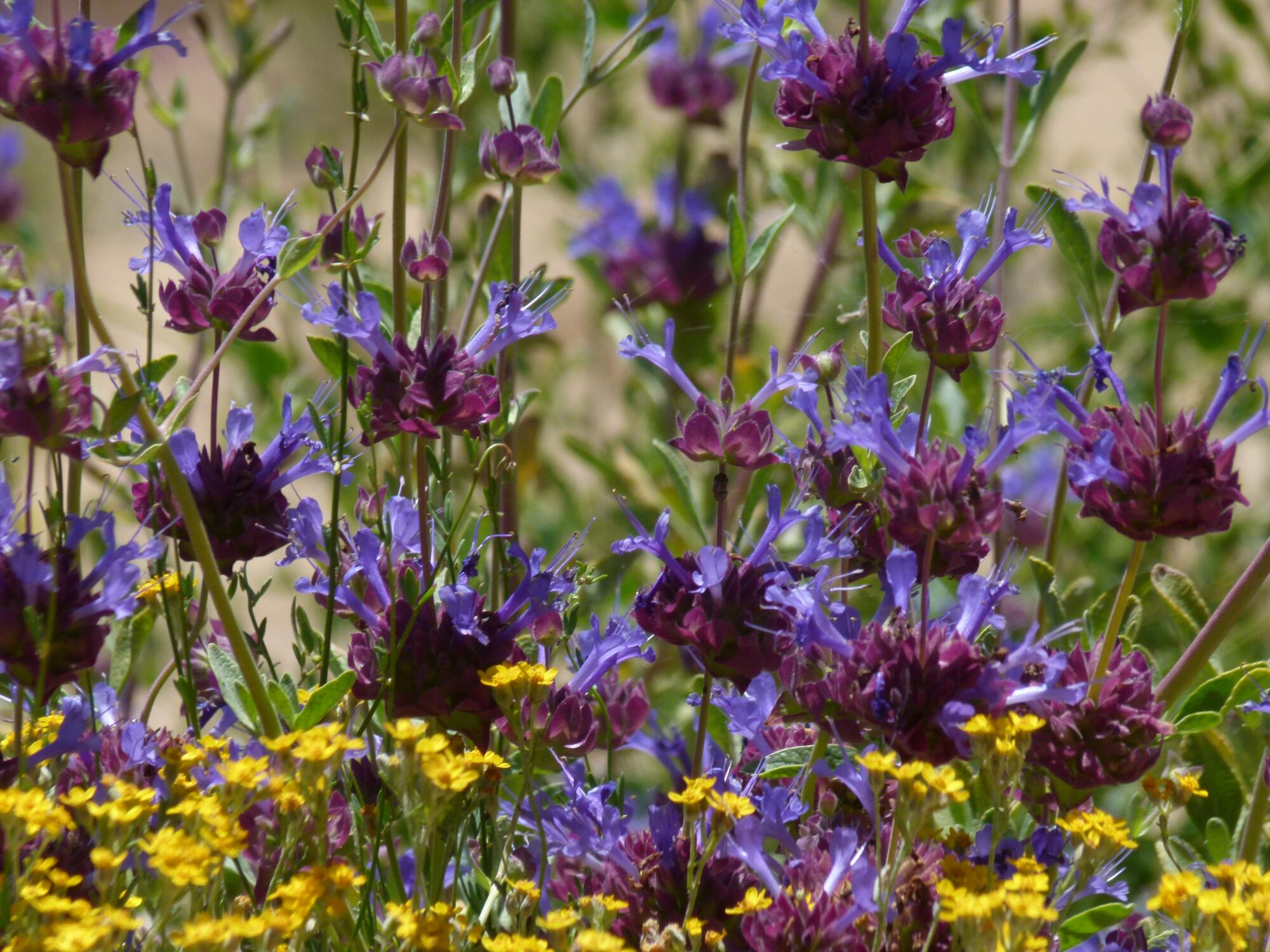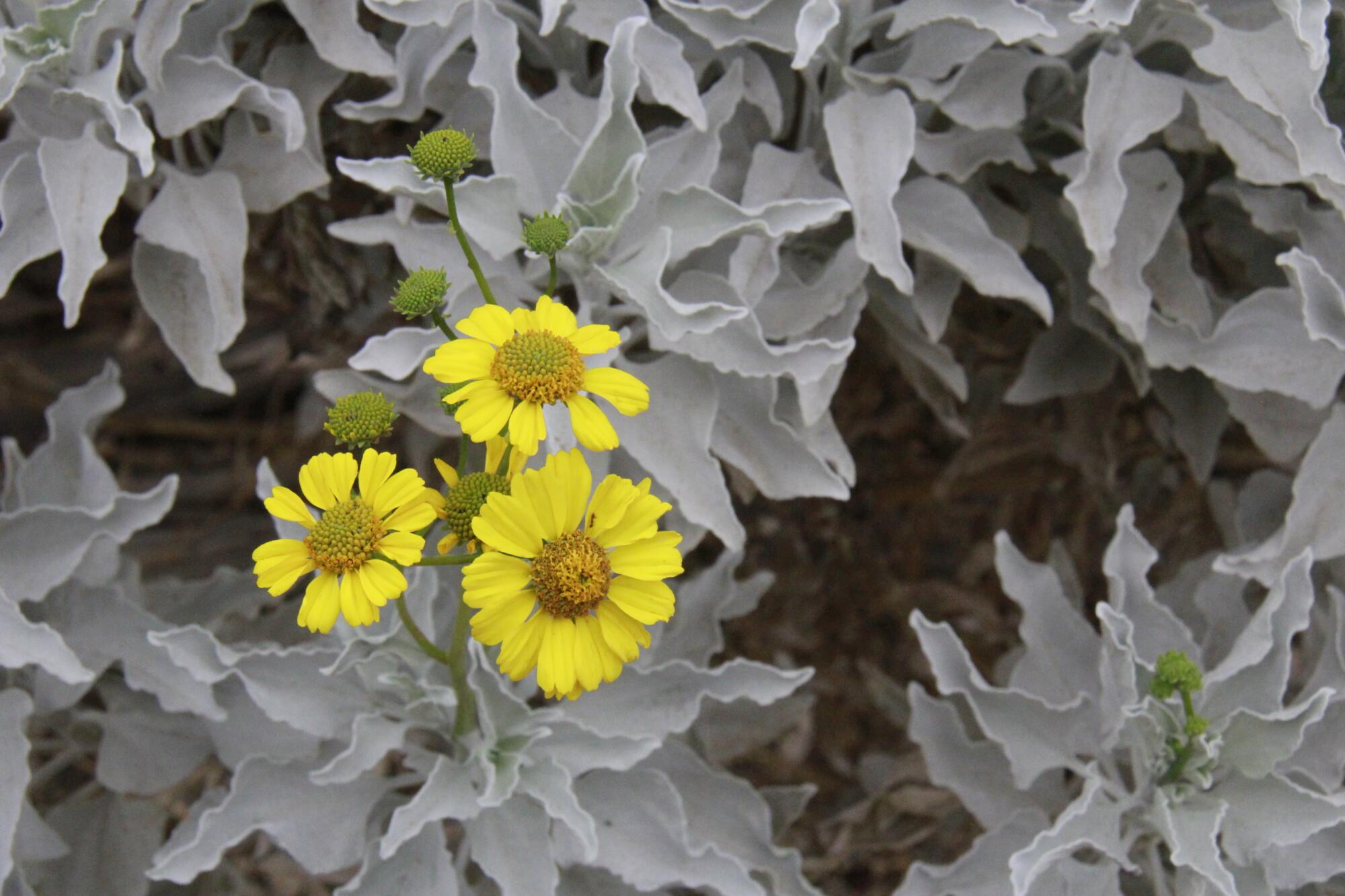So here’s the truth about California native plant landscapes: Without careful planning, they can get a little drab, especially in the summer when many go dormant, brittle and brown.
In climates where there’s ice and snow, we don’t fuss so much about dead-looking shrubs because, you know, it’s winter and plants are supposed to die back in the cold. But in sunny Southern California, many of our native plants adapted to hot, dry summers by choosing that time to go dormant. Which nowadays makes it hard for them to compete for landscape space when our nursery shelves are brimming with eye-popping non-native plants with flowers so gaudy they look plastic.
Yes, native plants are definitely authentic, and great for supporting our birds and pollinators, but their magic can be subtle in a landscape, one that takes time to appreciate. It’s a little like eliminating added sugars from your diet … it takes awhile for your taste buds to adjust to the flavors of unsweetened food, but once done, the artificial stuff, like ultraprocessed peanut butter loaded with sugar, for instance, never tastes so delicious.
So while your garden palate may need time to adjust, you don’t need to give up showstopping color to have a native plant landscape. It just takes a bit of research, planning and, like most of gardening, patience until the plants start to bloom.
Here is a subjective and by no means exhaustive list of 13 native plants with gorgeous flowers.
I got suggestions from several experts in the native plants world, including Tim Becker, horticulture director at the Theodore Payne Foundation; Mike Evans, co-owner of the Tree of Life Nursery in San Juan Capistrano; Lucinda McDade, executive director of the California Botanic Garden, the state’s largest botanic garden devoted to California native plants; Bob Sussman, owner of Matilija Nursery in Moorpark; and Penny Nyunt, manager of Las Pilitas Nursery in Santa Margarita, one of the state’s oldest native plant nurseries started by her mother, Celeste Wilson, and her father, Bert Wilson, who developed a couple of the showy cultivars listed below before his death in 2014. Although Las Pilitas Nursery is located in California’s central coast, most of its clientele, who order their plants online, are based in Los Angeles.
We also got suggestions from a charming subreddit called r/Ceanothus, which I recommend heartily to anyone with an interest in California native plants. If you want more suggestions — and there are many — try chatting with the helpful and knowledgeable people there.
The recommendations below are grouped by color and their prime flowering season. Please note: The best time to plant native shrubs and perennials is in the fall, so the plants have time to settle in during our typically cooler and wet winters (one hopes). This list is to help you plan. If you see something you really must have, contact your favorite native plant nursery and put in a request, to help ensure it’s available this fall, when you are ready to plant.
Yellows, creams, whites | Reds, oranges | Purples, blues | Winter bloomers
Hot season bloomers
Yellows, creams and whites
(California Botanic Garden)
California goldenrod (Solidago velutina ssp. californica) produces tall spikes of deep yellow flowers up to 5 feet tall in the summer and fall, so plant behind lower-growing plants to create a colorful backdrop. Prefers to be wet in winter and spring, dry in summer and fall, but can take some summer water. Beloved by birds and pollinators!

(Michael Wall / California Botanic Garden)
Desert marigold (a.k.a. wild marigold) (Baileya multiradiata) are very cheerful, yellow daisy-like flowers on tall stems that bloom profusely spring and summer. These are short-lived perennials that will reseed, and they seem to thrive in dry, nutrient-poor, fast-draining soil where other flowers fade.

California buckwheat (Eriogonum fasciculatum) produces clouds of white, pink-tinged blooms starting in late spring into fall, that turn a handsome, dramatic rust color at the end of the season. These are nice alone, but also spectacular on a hillside (you can see them along the cliffs in Laguna Beach, for instance), and pollinators like butterflies and native bees will thank you happily with many, many visits.

Coulter’s Matilija Poppy (Romneya coulteri) is also known as the fried egg plant, and it’s easy to see why once it starts to bloom, with massive, white crepe-papery flowers around large, yolk-colored centers. While the nickname doesn’t exactly sing, it’s very apt. The plant blooms into the summer and its flowers are so stunning people will stop to take photos, but be warned, this plant grows big and doesn’t play well with others — it tends to crowd other plants out — so plan carefully. If you have the space, it’s very effective planted in masses, especially on slopes, and it’s so tall that once it stops blooming it creates a feathery green wall behind whatever ornamental plants you want to add in front. One of the most effective landscape displays I’ve every seen is on the Cal State University Channel Islands campus in Camarillo (above), where masses are planted against the old stucco buildings on Ventura Street, creating a radiant display of breathtaking blooms bobbing and bouncing in the breeze. (And I wasn’t the only one stopping to take photos.)
Reds and oranges

Hollywood Flame Hummingbird Fuchsia (Epilobium canum ‘Hollywood Flame’) is one of the most attractive California fuchsias for landscaping and a profuse bloomer in late summer and fall, with narrow, gray-green leaves and tubular red flowers laced with yellow around the tips. Like all California fuchsias, this is a hummingbird magnet. Calscape, the California Native Plant Society’s plant database, says there is no better single plant than California fuchsias for attracting hummers.
Las Pilitas Nursery developed and first started selling this showy perennial and keeps planting more, but Nyunt says it sells out quickly, so keep trying. Another harder-to-find fuchsia that can stand some shade and has more ornamental, deeper green foliage is Wayne’s Silver Fuchsia (Epilobium septentrionale ‘Wayne’s Silver’). One possible source is Matilija Nursery, but call ahead to make sure it’s available for pickup (the nursery doesn’t ship). If you can’t find either of these popular cultivars, at least add one California fuchsia (Epilobium canum) to your garden since it’s guaranteed to provide bright scarlet splashes during SoCal’s hottest, dryest months. These plants die back in the winter (or you can cut them back). They spread and reemerge in the spring, looking a little weedy and dull at the start, but in the dog days of summer, when your native garden looks like it’s given up the ghost, stand back and watch your fuchsias explode with deep red blooms.

(California Botanic Garden)
Desert Globemallow (Sphaeralcea ambigua) blooms most of the year with vibrant, deep orange flowers and fuzzy, silvery green foliage if it gets a little irrigation in the summer and you cut it back about a third after its blooms are spent, says Sussman, who usually teaches a native plants landscaping class in the late fall through Conejo Valley Adult Education in Thousand Oaks. Also known as apricot mallow, this showy shrub has bowl-shaped flowers popular with pollinators and it’s available with white, lavender and deep reddish-orange blooms. A gorgeous variant known as Louis Hamilton Desert Mallow (Sphaeralcea ambigua ‘Louis Hamilton’) is harder to find (mostly because it sells out so quickly), but if you can get one, it’s deep reddish-coral flowers are true showstoppers.

Island Pink Yarrow (Achillea millefolium ‘Island Pink’) is a native of Santa Cruz Island that blooms in pale pink to deep rose bunches, like little bouquets, in spring and summer. Native yarrows also come in white like the Sonoma Coast Yarrow (Achillea millefolium ‘Sonoma Coast’), which produces beautiful masses of snowy white flowers that are popular with a host of pollinators, from bats and birds to butterflies and bees.
Purples and blues

(Deb Woo / California Botanic Garden)
Woolly bluecurls (Trichostema lanatum) bloom fall through spring, with gorgeous “curls” of deeply lavender/blue flowers and narrow, bright green leaves as sweetly fragrant as bubblegum. The trick to keeping this plant alive is to water it regularly when it’s first planted, but after a year or so, when the plant is established, stop watering, especially in the heat. Even occasional summer watering will kill it or shorten its life, which is only about four or five years anyway, but wow, what a gift to hummingbirds and other pollinators, not to mention anyone who loves a dramatic, fragrant garden. This one is worth the effort.

Celestial blue sage (Salvia ‘Celestial Blue’) is another super fragrant, vibrantly colorful native hybrid that blooms in spring and well into summer, with purple and electric blue pinwheels of flowers on tall stems. It is a cross between Cleveland sage (Salvia clevelandii), blue sage (Salvia pachyphylla) and purple sage (Salvia leucophylla) created by Bert Wilson of Las Pilitas Nursery.

(California Botanic Garden)
Coyote Mint (Monardella villosa) is a summer bloomer with pink or lavender pom-pom blooms on mid-size stems, and fragrant (minty), light green foliage. It spreads into a colorful groundcover, grows well in containers and is popular with pollinators.
Winter bloomers (into spring):

(Carrie Rosema / California Botanic Garden)
Showy Penstemon (Penstemon spectabilis) bloom profusely in almost electrically vibrant shades of violet infused with blue and pink. It is believed to be a host plant to more than a dozen butterflies and moths in their larval stage and it starts blooming in the late winter, when wildflowers are still trying to awake. Fast-growing, up to 4 feet tall, but can be short lived with too much water.

Brittlebush (Encelia farinosa) has sunny, yellow daisy-like flowers on a shrub with leaves so silvery green they almost look white; dramatic in the garden, blooms winter into spring. It can grow up to 5 feet tall, and may lose many of its leaves in the summer, but occasional hot-weather irrigation will help retain its foliage. Butterflies love its flowers, especially in the winter when native nectar is scarce, and birds feast on its seeds. Brittlebush thrives in dry conditions, according to Calscape, and is well suited for slopes and hillsides.

Pacific Coast irises (Iris ‘Pacific Coast’) are very showy first sparks of color after a long drab winter, sending up frilly, breathtaking flowers in almost every imaginable color as early as February, says breeder Sussman, who sells a wide variety of these native irises at Matilija Nursery. Native irises prefer shadier conditions than their cousins, the taller bearded irises that like full sun, but over time the plants will multiply so you can increase your holdings. Check out Sussman’s website to drool over his selection and call ahead to see if your favorites are available.
This story originally appeared on LA Times

